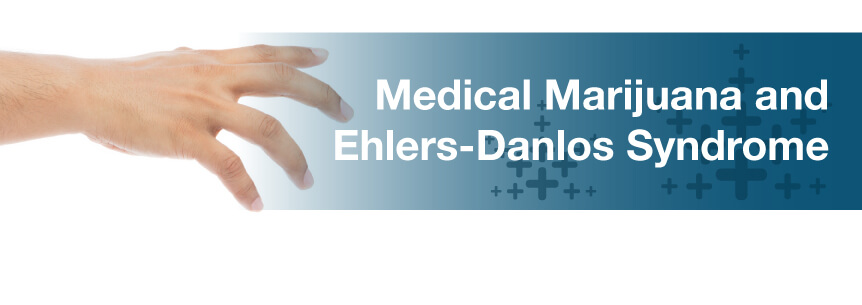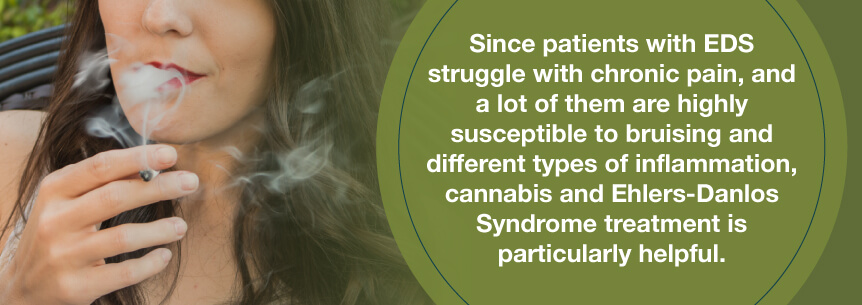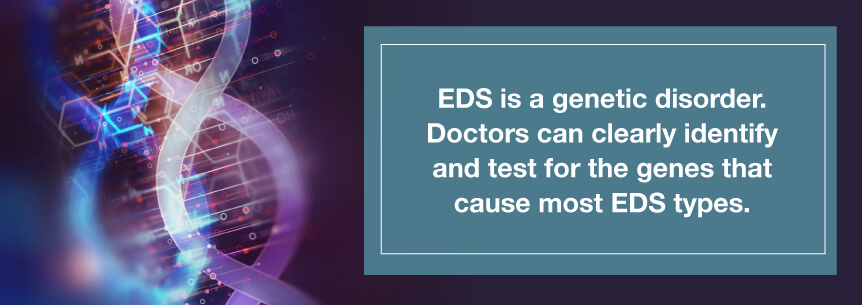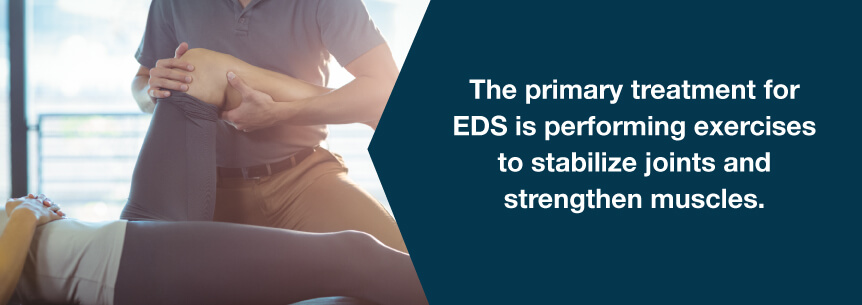
About one in 5,000 people is affected by a condition known as Ehlers-Danlos Syndrome, or EDS, which impacts the joints, skin and blood vessel walls. Several types of EDS exist, and the prognosis depends on the type and individual. Treatment, including the use of medical marijuana for Ehlers-Danlos, can help manage symptoms and avoid or minimize complications.
Medical marijuana and Ehlers-Danlos Syndrome treatment effectively helps patients manage their severe pain associated with this condition. Research supports medical weed’s pain-relieving effectiveness. Research links marijuana use with reduced pain and improving quality of life and function.
Medical pot and its cannabinoid components, like CBD and THC, react with the human brain’s and body’s cannabinoid receptors to provide three main capabilities:
Since patients with EDS struggle with chronic pain, and a lot of them are highly susceptible to bruising and different types of inflammation, cannabis and Ehlers-Danlos Syndrome treatment is particularly helpful.
Find A Doctor Find A Dispensary

Many patients with EDS also suffer from nausea and stomach pain, making medical weed uniquely qualified for treating these symptoms.
Tetrahydrocannabinol (THC) is the plant’s primary psychoactive component. Medicinally, it seems to work as a neuroprotective and alleviate moderate pain.
Cannabidiol (CBD), unlike THC, doesn’t provide any noticeable psychoactive effects. However, it does provide many essential medical properties. It also seems to synergistically work with THC, moderating its psychoactivity, while boosting its medical effects. CBD is also thought to enhance THC’s activity against pain and improve wakefulness. When you take CBD by itself, it has certain actions, which include:
It’s also a strong antioxidant and protects against oxidation-related chemical damage.
Where pain is associated with inflammation, studies show medical marijuana for Ehlers-Danlos Syndrome provides site-specific anti-inflammatory relief. Many individuals report the herb doesn’t affect their ability to function regularly like opioids do. In fact, the herb has helped many patients dramatically reduce or even eliminate their need to take opioids or other similar narcotic painkillers.
Cannabis for Ehlers-Danlos Syndrome treatment helps reduce joint pain suffering. Research indicates cannabis improves:
Other research shows medical pot blocks arthritis progression effectively.
Patients experience a wide range of symptoms with EDS. Traditionally, doctors prescribe a different medication for each symptom — inflammation, muscle spasms, depression, nausea, pain, poor sleep, etc.
Medical weed can help treat all these symptoms and more, allowing many patients to happily replace multiple prescription medications with one holistic therapy.
EDS patients who took marijuana and Ehlers-Danlos Syndrome treatment — mainly cannabis extracts or vaporized or smoked cannabis — found total relief from:
Some individuals claimed they found better relief for their headaches with Sativa strains of weed.
Medical cannabis comes in two strains — Indicas and Sativas. The type you decide to use determines what effects you’ll experience. Each comes with a unique set of characteristics.
Some potentially helpful medical marijuana and Ehlers-Danlos Syndrome strains to try include:
Research supports vaping reduces smoking’s negative effects and risk of respiratory symptoms. While vaping and smoking are the easiest ways to feel marijuana’s beneficial effects instantly, they’re not the only ways to receive your treatment. Patients can also consume their marijuana for Ehlers-Danlos Syndrome treatment through cakes, butter, sauces, cookies, etc. They can drink the herb in juices, teas or tinctures.
Other cannabis delivery methods include:
Cannabinoid therapies are evolving, and you now have many products available to you for the relief of your symptoms. Your first step is to find a cannabis doctor who will provide you your recommendation and then search for a marijuana dispensary to buy your medical cannabis for Ehlers-Danlos Syndrome products. You can do both of these and more at MarijuanaDoctors.com.
Find A Doctor Find A Dispensary
EDS, which is also called cutis elastica, is a cluster of inherited conditions that affect your body’s connective tissues — mostly your joints, skin and blood vessel walls. Your connective tissue is a multiplex combination of proteins and other components that provide your body’s underlying structures with elasticity and strength.
EDS usually results from a gene defect or mutation or defect involved in producing and regulating collagen, which is the main protein comprising the human body’s connective tissue.
EDS patients generally have overly fragile, stretchy skin and flexible joints. This can cause problems when you have a wound requiring stitches, since your skin, in many cases, isn’t strong enough to keep them in place.
The vascular type of EDS is a more severe form of the condition and can cause your blood vessel walls, uterus or intestines to rupture. Since vascular EDS may cause potentially severe complications in pregnancy, if you’re looking to start a family, you’ll want to consult with a genetic counselor first.
Parents sometimes silently carry the EDS-causing defective genes, meaning they often don’t have any symptoms of the disorder. In fact, they often aren’t even aware they’re defective gene carriers. In some instances, however, there’s a dominant gene which does cause symptoms.
Symptoms of Ehlers-Danlos syndrome include:
The symptoms of EDS can be lifelong or chronic.
EDS is a genetic disorder. Doctors can clearly identify and test for the genes that cause most EDS types. However, hypermobility EDS (hEDS) is the most common form and is an exception to this rule, since doctors haven’t identified the gene that causes it yet.

The common EDS types show autosomal dominant inheritance. This means if you’ve inherited one faulty gene from a parent, you’ll have the disorder — and so will one of your parents. The rarer EDS types show autosomal recessive inheritance, meaning you require two copies of this faulty gene for you to develop the disorder — a gene from each parent. If your parents each only have one faulty gene, they don’t have the disorder.
There are various EDS types, each with its own set of complications and features. As mentioned, hypermobility Ehlers-Danlos is the most common form of EDS. It’s characterized by chronic joint pain and loose joints. Other types of EDS may involve potentially life-threatening and serious complications, including:
All types include:
Each type has its own criteria.
In 400 BCE, Hippocrates first described EDS, according to the British Journal of Haematology. In 1901, Edvard Ehlers recognized the disorder as its own entity. Henri-Alexandre Danlos, in 1908, suggested the cardinal features of the disorder were skin fragility and extensibility. Beighton, in 1998, published the Villefranche nosology classification of EDS. The genetic makeup of the disorder was identified from the 1960s and the management of bleeding complications linked with EDS has a slow progression.
Complications of Ehlers-Danlos Syndrome may include:
There’s a link between EDS and sleep problems, according to a report provided by Alan G. Pocinki, M.D., a clinical associate professor at George Washington University.

Non-restorative sleep in the disorder includes:
Depression and anxiety disorders are also common in patients with hEDS. Also in hEDS, there’s a strong association between chronic pain and psychiatric problems. While there still needs to be more research, some evidence shows a connection between other psychiatric conditions and hEDS.
As the American Journal of Medical Genetics Part C Seminars in Medical Genetics reported, growing evidence also shows an association with neuro-developmental disorders and eating and tobacco and alcohol misuse. Mental health problem management may involve psychotherapy and drug treatment.
Statistics reported by Virtual Medical Centre reveal:
EDS has no cure, but treatment can help prevent further complications and manage your symptoms. It includes learning how to prevent injuries and protect your joints.
Preventing injuries is important when you have EDS. A few ways to safeguard yourself include:
Your doctor might prescribe certain medications to help manage:
OTC pain relievers like ibuprofen (Motrin IB, Advil), acetaminophen (Tylenol) and naproxen sodium (Aleve) are the typical first line of treatment. Your doctor probably won’t prescribe stronger medications unless you have an acute injury. Side effects of ibuprofen and naproxen may include:
Acetaminophen may cause:
Since in some types of EDS your blood vessels are more fragile, your doctor will keep your blood pressure low to reduce the stress on them.
Joints that have weak connective tissue have a higher risk of dislocating. The primary treatment for EDS is performing exercises to stabilize joints and strengthen muscles. Your physical therapist may also suggest specific braces to avoid joint dislocations.

Your doctor may recommend surgery to repair damaged joints from repeated dislocations. However, your connective tissue and skin of your affected joint might not properly heal following your surgery. Some patients with the vascular type of EDS require surgery to repair ruptured organs or blood vessels.
Side effects of any surgery may include:
Talk with your doctor before starting any treatment to go over the risks and benefits.
Researchers discovered a new, autosomal recessive type of EDS, according to The Ehlers-Danlos Society. It’s extremely rare, and as of right now, only four people from three unrelated families have it.
However, Johns Hopkins University’s Dr. Hal Dietz wrote about a study intended for developing a method of medically managing vascular complications that come with EDS, like arterial rupture and aneurysms.
For EDS patients with these severe problems, surgery could be just as life-threatening as the problem itself. Therefore, identifying a non-surgical method of treating such fatal complications can drastically change patients’ outcomes.